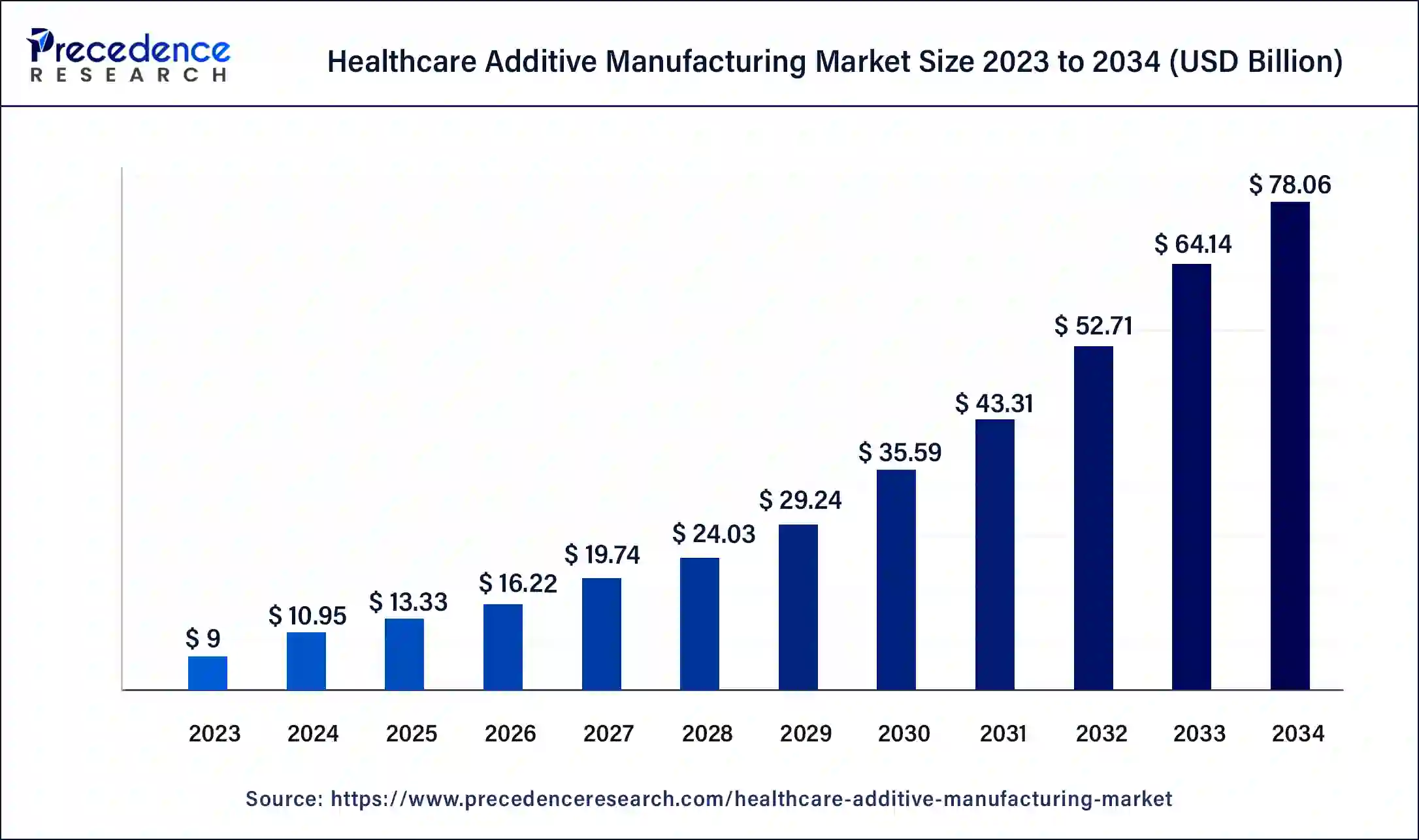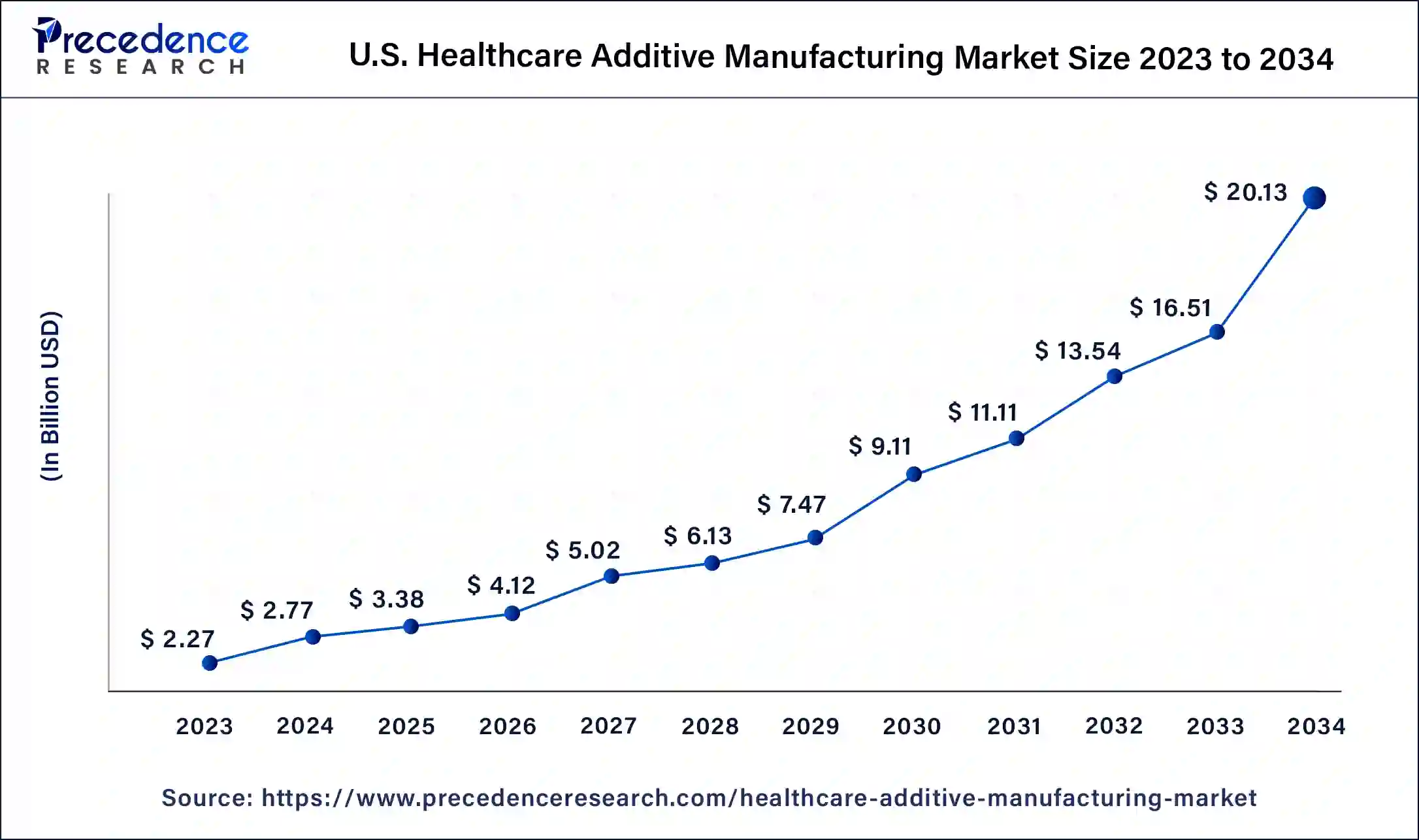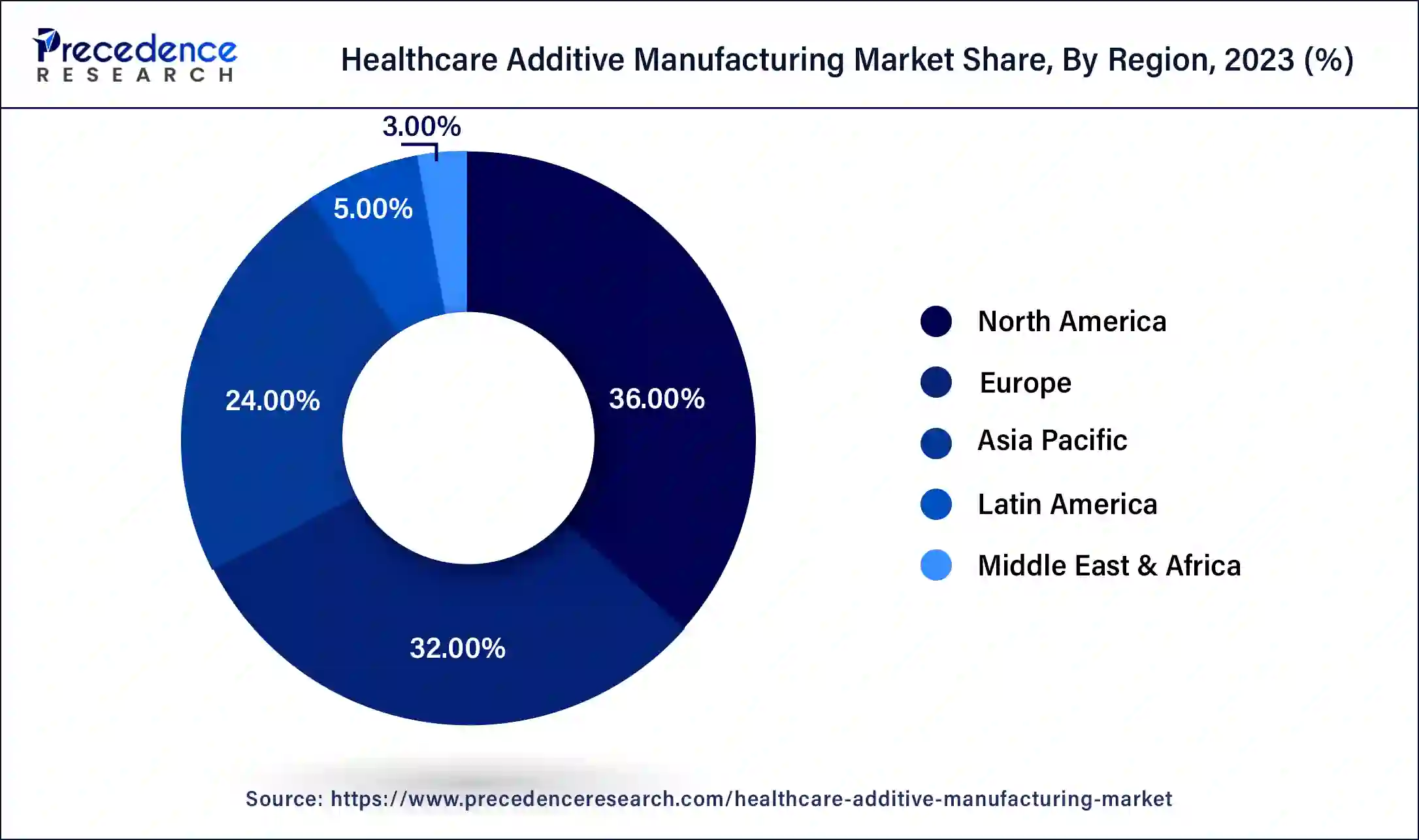January 2025
The global healthcare additive manufacturing market size was USD 9 billion in 2023, calculated at USD 10.95 billion in 2024 and is expected to reach around USD 78.06 billion by 2034, expanding at a CAGR of 21.7% from 2024 to 2034.
The global healthcare additive manufacturing market size accounted for USD 10.95 billion in 2024 and is expected to reach around USD 78.06 billion by 2034, expanding at a CAGR of 21.7% from 2024 to 2034. The North America healthcare additive manufacturing market size reached USD 3.24 billion in 2023.

The U.S. healthcare additive manufacturing market size was estimated at USD 2.27 billion in 2023 and is predicted to be worth around USD 20.13 billion by 2034, at a CAGR of 21.9% from 2024 to 2034.

North America is expected to dominate the market with a revenue share of more than 36% in 2023 and is expected to grow significantly during the forecast period owing to the presence of major market players in the region such as GE Additive, 3D Systems, Inc., Stratasys Ltd., and many others investing heavily in research and development of new technology healthcare devices. Also, the favorable Government regulations in the U.S. are fostering the market growth. For instance, On 8th September 2021, 3D Systems has acquired Oqton, a software business that is a pioneer in the development of an intelligent, cloud-based Manufacturing Operating System (MOS) platform. This acquisition will aid 3D Systems in the development of flexible production environments that increasingly include a variety of advanced manufacturing and automation technologies, including additive manufacturing (AM) solutions, into their manufacturing processes.

Asia Pacific is also anticipated to be the fastest growing market in the upcoming years due to the presence of developing economies and the availability of large population in India and China that requires advanced medical facilities. Moreover, the demand in dental 3D printing due to the rise in people count undergoing tooth replacement surgeries will fuel the market growth. Also, the rising cases of arthritis and the fast growing healthcare infrastructure are estimated to drive the growth of the Healthcare Additive Manufacturing Market in the Asia Pacific region.
The increasing need for customization of medical products such as implants is expected to drive the market growth. The advent of advanced technologies such as 3D printing is expected to provide cost-effective ways to produce complex medical components and parts. The growing demand and the unmet needs due to an increase in the number of procedures and hospitalizations in the healthcare sector the surge in chronic disorders are the factors that are expected to fuel the growth of the healthcare additive manufacturing market.
Additive Manufacturing (AM) permits the manufacturing of complex designs that are difficult or expensive to be developed using the traditional machinery, molds, milling, and dies. It helps in rapid prototyping and offers a dynamic and design-driven process. Additive manufacturing is suitable for prototyping using CAD, as it removes the time-consuming procedure and higher costs involved with the production of complicated devices.
Polymers are extensively used additive manufacturing materials because of its potential to be used in various applications of the healthcare industry. This factor is expected to drive the growth of the market.
| Report Highlights | Details |
| Growth Rate from 2024 to 2034 | CAGR of 21.7% |
| Market Size in 2023 | USD 9 Billion |
| Market Size in 2024 | USD 10.95 Billion |
| Market Size by 2034 | USD 15.35 Billion |
| Base Year | 2023 |
| Forecast Period | 2024 to 2034 |
| Largest Market | North America |
| Fastest Growing Market | Asia Pacific |
| Segment Covered | By Technology, By Material, By Application, and By Region |
| Regions Covered | Asia Pacific, North America, Europe, Latin America, Middle East and Africa |
Based on the Technology, the Healthcare Additive Manufacturing Market is divided into Stereolithography, Deposition Modeling, Electron Beam Melting, Laser Sintering, Jetting Technology, Laminated Object Manufacturing and Others.
Laser sintering technology segment dominated the market in 2023 accounting for more than 31.5% revenue share and is expected to grow significantly during the forecast period. The Laser Sintering (SLS) method is used to produce several pieces at a time without the need for any support to build objects to be used un the healthcare industry. This factor drives the market growth.
The deposition modeling segment is expected to increase at the fastest rate during the forecast period, allowing for the production of precise prototypes and complex forms out of photosensitive resins. Stereo lithography Technology segment is also predicted to make a significant contribution to market expansion because to its effectiveness in producing orthodontic and prosthetic parts that provides precise models with fine features and a smooth surface aspect.
Based on the Material, the Healthcare Additive Manufacturing Market is divided into Metals & Alloys, Polymers, Biological Cells and Others.
The polymer material segment dominated the market in 2023 contributing more than 55% of revenue share and is anticipated to grow remarkably during the forecast period. The polymer materials are widely used in the healthcare industry to create medical instruments, prosthetic limbs and related accessories. Some of the appealing characteristics that have made polymers the most widely used kind of material for AM techniques include Synthetic versatility & adaptability and numerous other properties of polymer materials. For medical education purpose Polymer-based models are extensively utilized. The Polymer-based models assist in implant designing, diagnosis and training & preoperative planning. Models of different body organs and body parts can be developed using the polymers and these models are used for practicing various delicate surgical operations.
Due to their increased use in surgical implants, the metal and alloys material category also contributed considerably in 2023 and will continue to do so in the future years. Due to their advantageous properties such as corrosion resistance, biocompatibility, and high strength, metals and alloys such as stainless steel, titanium, and cobalt-based alloys are commonly employed in the healthcare business. Medical implants made from cobalt chrome metal powder offer a good biocompatibility and a hardness that ensures long-term function. All of these factors are propelling the Healthcare Additive Manufacturing Market forward.
Based on the Application, the Healthcare Additive Manufacturing Market is divided Prosthetics, Wearable Devices, Medical Implants, Tissue Engineering and Others. The medical implant segment contributed the largest share in 2023 accounting for more than 32% revenue share and is expected to grow significantly in the upcoming years because of the rise in adoption of orthopedic implants. The surge in geriatric population across the world has led to the rise in demand for orthopedic procedures, such as knee & hip replacements. Also, the increasing demand for trauma-associated devices, such as spinal implants has positively impacted the growth of the Healthcare Additive Manufacturing Market.
In the dental industry, Additive manufacturing is also increasingly used in scanning the mouth of the patient to develop accurate and customized solutions to fix problems associated with dental care. Also, many machines and materials are developed especially for dental treatments. All these attributes are expected to foster the market growth.
By Technology
By Material
By Application
By Geography
For inquiries regarding discounts, bulk purchases, or customization requests, please contact us at sales@precedenceresearch.com
No cookie-cutter, only authentic analysis – take the 1st step to become a Precedence Research client
January 2025
December 2024
February 2025
April 2024